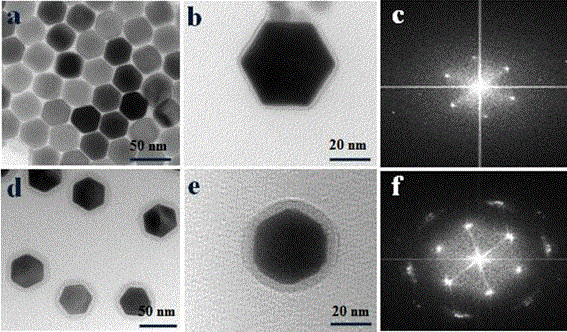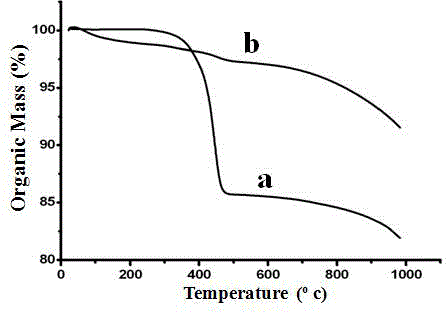Lectin-functionalized-hydrophilic-polymer-coated up-conversion fluorescence nanoparticle and application and preparation method thereof
A technology of fluorescent nanoparticles and hydrophilic polymers, applied in chemical instruments and methods, fluorescence/phosphorescence, preparations for in vivo experiments, etc., can solve problems such as the inability to achieve fast, real-time, in situ cell membrane sugar analysis , to achieve the effects of increasing contact probability and affinity, increasing immobilization capacity, good hydrophilicity and biocompatibility
- Summary
- Abstract
- Description
- Claims
- Application Information
AI Technical Summary
Problems solved by technology
Method used
Image
Examples
preparation example Construction
[0041] A method for preparing lectin-functionalized hydrophilic polymer-wrapped up-conversion fluorescent nanoparticles, comprising the following steps:
[0042] 1) Prepare rare earth metal-doped up-conversion fluorescent nanoparticles with rare earth inorganic acid salts as precursors and oleic acid and octadecene as stabilizers; the rare earth inorganic acid salts used can be YCl3, ErCl3, YbCl3, or YbF3, GdF3 , ErFl3, etc.;
[0043] 2) Use the SI-ATRP initiator with a carboxyl group at one end and an ATRP initiator at the other end, and use the carboxyl group of the molecule to perform an arm exchange reaction with the oleic acid molecule on the surface of the upconversion fluorescent nanoparticle, thereby immobilizing the SI-ATRP initiator on the surface Convert fluorescent nanoparticle surfaces;
[0044] 3) In the presence of a monomer and a catalyst system, atom transfer radical polymerization is initiated on the surface of the upconversion fluorescent nanoparticle immob...
Embodiment 1
[0058] SI-ATRP method was used to prepare hydrophilic polymer-wrapped up-converting fluorescent nanoparticles and immobilize lectin.
[0059] 1.1 Immobilization of SI-ATRP initiator. The SI-ATRP initiator is immobilized on the surface of the upconversion fluorescent nanoparticle by using the carboxyl end of the SI-ATRP initiator to undergo an arm exchange reaction with the oleic acid molecule on the surface of the prepared upconversion fluorescent nanoparticle. First, mix 20mg of up-converting fluorescent nanoparticles with 2-bromoisobutyl bromide (168mg) and add them into 4ml of chloroform and react at 40°C for 2 hours under nitrogen protection, centrifuge at 13000g for 10min and wash with 1ml of chloroform The residual SI-ATRP initiator was washed repeatedly for 3 times, and stored in a refrigerator at 4°C under nitrogen protection for future use.
[0060] 1.2 Initiate SI-ATRP response. In situ generation of polyethylene glycol methyl methacrylate polymer chains on the sur...
Embodiment 2
[0065] Characterization of the crystal form and core-shell structure of the prepared hydrophilic polymer-wrapped upconverting fluorescent nanoparticles
[0066] 2.1 figure 1 TEM characterization photographs of upconverting fluorescent nanoparticles. a and b are up-conversion fluorescent nanoparticles immobilized with SI-ATRP initiator, and the particles are of the hexagonal β type with the highest quantum efficiency. Figures c and d are upconverting fluorescent nanoparticles modified by SI-ATRP reactive hydrophilic polymers. A polymer layer appeared around the particles, forming an obvious core-shell structure, and the inner core was still hexagonal, indicating that the SI-ATRP polymerization method can realize the hydrophilic polymer wrapping of the particles without destroying the crystal form. figure 1 e and f are transmission electron microscope photos after Fourier transform. It can be seen from the figure that the six diffraction angles of the hexagonal particles can b...
PUM
| Property | Measurement | Unit |
|---|---|---|
| particle diameter | aaaaa | aaaaa |
| particle diameter | aaaaa | aaaaa |
| thickness | aaaaa | aaaaa |
Abstract
Description
Claims
Application Information
 Login to View More
Login to View More - R&D
- Intellectual Property
- Life Sciences
- Materials
- Tech Scout
- Unparalleled Data Quality
- Higher Quality Content
- 60% Fewer Hallucinations
Browse by: Latest US Patents, China's latest patents, Technical Efficacy Thesaurus, Application Domain, Technology Topic, Popular Technical Reports.
© 2025 PatSnap. All rights reserved.Legal|Privacy policy|Modern Slavery Act Transparency Statement|Sitemap|About US| Contact US: help@patsnap.com



